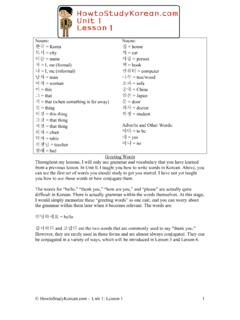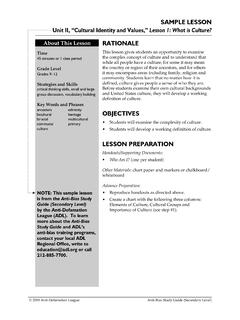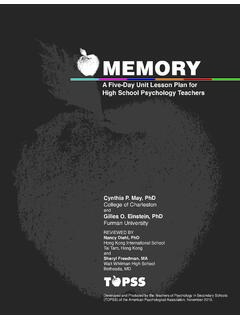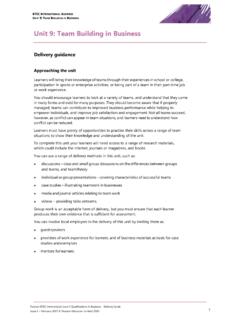Transcription of Unit 1 Overview Weather and Climate Grade: 3 Essential ...
1 unit 1 Overview Weather and Climate Grade: 3 Content Area: Earth and Space Science Pacing: 15 days Essential Question What is the typical Weather near our home? How can we protect people from Weather -related hazards? Student Learning Objectives (Performance Expectations) 3-ESS2-1: Represent data in tables and graphical displays to describe typical Weather conditions expected during a particular season. 3-ESS3-1: Make a claim about the merit of a design solution that reduces the impacts of a Weather -related hazard. 3-ESS2-2. Obtain and combine information to describe climates in different regions of the world. unit Summary In this unit of study , students organize and use data to describe typical Weather conditions expected during a particular season. By applying their understanding of Weather -related hazards, students are able to make a claim about the merit of a design solution that reduces the impacts of such hazards.
2 The crosscutting concepts of patterns, cause and effect, and the influence of engineering, technology, and science on society and the natural world are called out as organizing concepts for these disciplinary core ideas. Students demonstrate grade-appropriate proficiency in asking questions and defining problems, analyzing and interpreting data, engaging in argument from evidence, and obtaining, evaluating, and communicating information. Students are also expected to use these practices to demonstrate understanding of the core ideas. Technical Terms Temperature, Precipitation, Pictograph, Climate Range, Predictions, Weather Forecast, Weather Patterns, Cold Front, Warm Front, Absolute Zero, North Pole, South Pole, Radar, Air Quality, Satelite, Severe Weather , Hurrican, Typhoon, Surface Weather , Snow Cover, Fire Weather , Doppler Radar, Athmosphere, Meteorologists, Weather Vane, Anemometer, Hurricane, NASA, Tree Rings, Athmospheric Composition, Coral Bleaching, Rain Stick, El Ni o, Greenhouse Effect, Horizon, Flood Barrier, Drought, Lightning Rod, Flash Flood, Thunder Storm Formative Assessment Measures Part A: Can we predict the kind of Weather that we will see in the spring, summer, autumn, or winter?
3 Students who understand the concepts can: Make predictions using patterns of change Represent data in tables, bar graphs, and pictographs to reveal patterns that indicate relationships. Represent data in tables and graphical displays to describe typical Weather conditions expected during a particular season. (Assessment of graphical displays is limited to pictographs and bar graphs. Assessment does not include Climate change.) Examples of data could include: Average temperature, Precipitation, Wind direction Part B: How can climates in different regions of the world be described? Students who understand the concepts can: Make predictions using patterns of change. Obtain and combine information from books and other reliable media to explain phenomena. Part C: How can we protect people from natural hazards such as flooding, fast wind, or lightening?
4 Students who understand the concepts can: Identify and test cause-and-effect relationships to explain change Make a claim about the merit of a solution to a problem by citing relevant evidence about how it meets the criteria and constraints of the problem. Make a claim about the merit of a design solution that reduces the impacts of a Weather -related hazard. Examples of design solutions to Weather related hazards could include: Barriers to prevent flooding Wind-resistant roofs Lightning rods Define a simple design problem that can be solved through the development of an object, tool, process, or system and include several criteria for success and constraints on materials, time, or cost. Define a simple design problem reflecting a need or a want that includes specified criteria for success and constraints on materials, time, or cost.
5 Interdisciplinary Connections NJSLS- ELA NJSLS- Mathematics Ask and answer questions to demonstrate understanding of a text, referring explicitly to the text as the basis for the answers. (3-ESS2-2) Reason abstractly and quantitatively. (3-ESS2-1),(3-ESS2-2),(3-ESS3-1) Compare and contrast the most important points and key details presented in two texts on the same topic. (3-ESS2-2) Model with mathematics. (3-ESS2-1),(3-ESS2-2), (3-ESS3-1) Write opinion pieces on topics or texts, supporting a point of view with reasons. (3-ESS3-1) Use appropriate tools strategically. (3-ESS2-1) Conduct short research projects that build knowledge about a topic. (3-ESS3-1) Measure and estimate liquid volumes and masses of objects using standard units of grams (g), kilograms (kg), and liters (l). Add, subtract, multiply, or divide to solve one-step word problems involving masses or volumes that are given in the same units, , by using drawings (such as a beaker with a measurement scale) to represent the problem.
6 (3-ESS2-1) Recall information from experiences or gather information from print and digital sources; take brief notes on sources and sort evidence into provided categories. (3-ESS2-2) Draw a scaled picture graph and a scaled bar graph to represent a data set with several categories. Solve one- and two-step how many more and how many less problems using information presented in bar graphs. (3-ESS2-1) Core Instructional Materials Can include: Textbooks Series, Lab Materials, etc. 21st Century Life and Careers CPR1, CPR2, CPR4, CPR5, CPR6, CPR7, CPR8, CPR11, CPR12 Technology Standards , , , , , , , , , , , , , , , Modifications English Language Learners Special Education At-Risk Gifted and Talented Scaffolding Word walls Sentence/paragraph frames Bilingual dictionaries/translation Think alouds Read alouds Highlight key vocabulary Annotation guides Think-pair- share Visual aides Modeling Cognates Word walls Visual aides Graphic organizers Multimedia Leveled readers Assistive technology Notes/summaries Extended time Answer masking Answer eliminator Highlighter Color contrast Teacher tutoring Peer tutoring study guides Graphic organizers Extended time Parent communication Modified assignments Counseling Curriculum compacting Challenge assignments Enrichment activities Tiered activities Independent research/inquiry Collaborative teamwork Higher level questioning Critical/Analytical thinking tasks Self-directed activities Grade 3 unit 1.
7 Weather and Climate 3-ESS2: Earth's Systems 3-ESS2-1: Represent data in tables and graphical displays to describe typical Weather conditions expected during a particular season. Clarification Statement: Examples of data could include average temperature, precipitation, and wind direction. Assessment Boundary: Assessment of graphical displays is limited to pictographs and bar graphs. Assessment does not include Climate change. Evidence Statement: 3-ESS2-1 Science & Engineering Practices Disciplinary Core Ideas Cross-Cutting Concepts Analyzing and Interpreting Data : Weather and Climate Patterns Analyzing data in 3 5 builds on K 2 experiences and progresses to introducing quantitative approaches to collecting data and conducting multiple trials of qualitative observations. When possible and feasible, digital tools should be used. Scientists record patterns of the Weather across different times and areas so that they can make predictions about what kind of Weather might happen next.
8 (3-ESS2-1) Patterns of change can be used to make predictions. (3-ESS2-1),(3-ESS2-2) Represent data in tables and various graphical displays (bar graphs and pictographs) to reveal patterns that indicate relationships. (3-ESS2-1) Climate describes a range of an area's typical Weather conditions and the extent to which those conditions vary over years. (3-ESS2-2) Obtaining, Evaluating, and Communicating Information Obtaining, evaluating, and communicating information in 3 5 builds on K 2 experiences and progresses to evaluating the merit and accuracy of ideas and methods. Obtain and combine information from books and other reliable media to explain phenomena. (3-ESS2-2) Connections to other DCIs in this grade-band: N/A Articulation of DCIs across grade-bands: , , , , NJSLS- ELA: , , NJSLS- Math: , , , , 5E Model 3-ESS2-1: Represent data in tables and graphical displays to describe typical Weather conditions expected during a particular season.
9 Engage Anticipatory Set Following these videos, teacher will lead discussion on the four seasons, including typical Weather forecasts and activities we do in the respective season, as well as the ways in which Weather is measured. BrainPOP: Weather & Temperature How Windy is Too Windy? Students will watch a brief video of the top of Mount Washington, showing just how powerful wind can be. Weather and Seasons What is Weather ? Students will discuss what they know about Weather and how they think it should be measured. Exploration Student Inquiry Step by Step Weather Observations In this activity, students will take their own readings of air temperatures using an outdoor thermometer and then compare their readings those from the National Weather Service, as well as determine normal yearly average temperatures. Use the link below to compare student data to National Weather Service data.
10 Seasonal Weather Patterns: Temperature & Precipitation In this activity, students will predict monthly patterns of temperature and precipitation. Given a set of data, students will represent these data on temperature and precipitation graphs. Students will then use their graphs to draw conclusions on Weather patterns. Create a Weather Map In this lesson, students draw pictures that symbolize different types of Weather and then use information about today's Weather to make their own state Weather map. Plotting Climate Data In this lessons, students will use Climate data to create a key, plot data points, and interpolate data. Explanation Concepts and Practices In these lessons: Teachers Should: Introduce formal labels, definitions, and explanations for concepts, practices, skills or abilities. Students Should: Verbalize conceptual understandings and demonstrate scientific and engineering practices.







